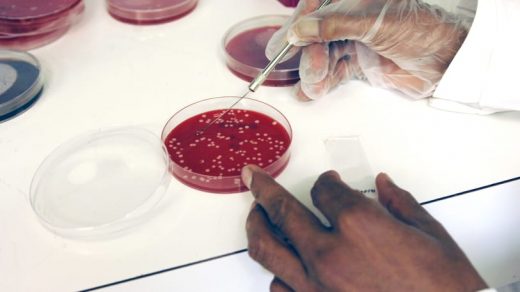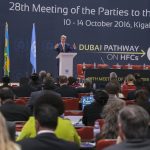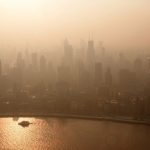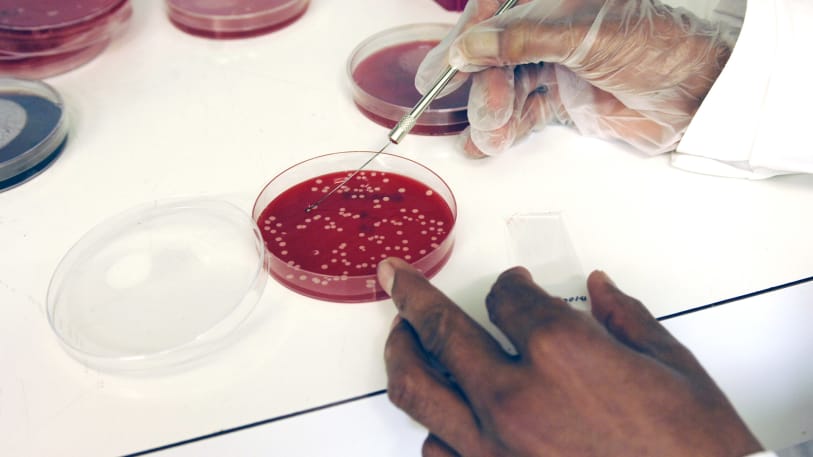This Is How The World Gets Sick
In an exclusive excerpt from Deadliest Enemy, a new book on the threat of emerging diseases, epidemiologist Dr. Michael T. Osterholm and writer Mark Olshaker present a fictional tabletop-like scenario involving an influenza pandemic in today’s world, with the virulence of 1918’s H1N1 strain, which resulted in the deaths of 50 million to 100 million people. This scenario has been reviewed by colleagues in public health preparedness and business continuity planning. There is general agreement that it is realistic and possible. Keep that in mind as you imagine yourself and your family living through it.
At first, the doctors in the Shanghai metropolitan area think they’re just seeing late-season flu cases, but their patients don’t seem to be getting better. It is mid-April; influenza should be on the wane in China. It doesn’t take long for physicians to realize that the hundreds of patients they are seeing in emergency rooms are presenting with conditions very different from anything they have seen before. At least 50 patients have died of acute respiratory distress syndrome (ARDS) in the past two days; intensive care units in many hospitals in the area can no longer admit new patients—they are bursting at the seams. In many cases, the victims report they had been sick for only a day or two, sometimes only hours. The majority of the victims are otherwise healthy young adults and pregnant women.
Clinicians quickly recognize that these patients have a similar devastating illness to the 1,000-plus Chinese who had been diagnosed with one of the bird flu infections in the past several years. Still, this is different: In the past, bird flu cases occurred only sporadically by location and time, rarely with multiple cases in one family. Now, emergency rooms and even intensive care units in hospitals all over the Shanghai area are awash in desperately ill patients.
The worst fears of Chinese public health officials are realized when sputum samples from eight patients hospitalized in three different facilities are confirmed to have H7N9 influenza infection. H7N9—an avian virus by origin that made its first recognized foray into the human population of China in 2013—has now taken the last major step to becoming the pandemic influenza virus.
Meanwhile, more cases are popping up in other places. In areas of China where this strain has been previously detected, about a third of those who contracted the disease from poultry have died. But the birds carrying the virus don’t get sick or, at least, they don’t display any noticeable symptoms. Within days, cases of H7N9 influenza begin showing up in hospitals throughout much of China and even other countries in Asia. Many of the first cases outside of Shanghai had recently traveled to the city. This story has gone from one of relative obscurity to the No. 1 news story in the world.
Even before Chinese public health officials could confirm that the rapidly growing health crisis in the Shanghai area was the likely first sign of an emerging influenza pandemic, cases begin to show up all over the world. Almost all of the early cases had just recently returned from travel to Shanghai and neighboring cities and towns. But that changes quickly when hospitals in other countries receive cases that had never been to China.
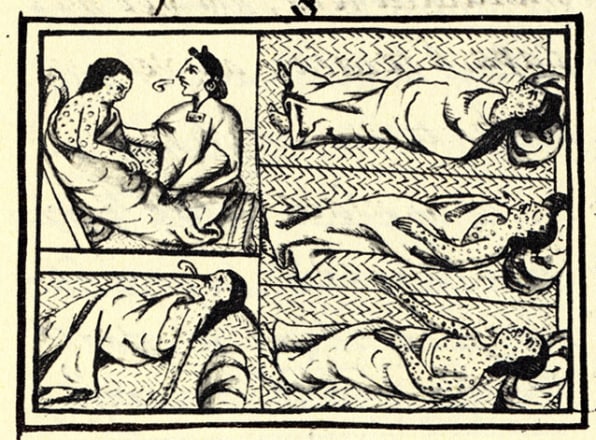
The WHO, the CDC, and other national health organizations around the world commence their methodical disease detective work. They identify the early cases that presented at each worldwide location and trace their travels back in the weeks before they became ill. Their investigation confirms everyone’s worst fear: We are watching the early days of a quickly growing pandemic. No use closing borders; H7N9 has probably taken root in 30 or 40 countries by now.
The increasingly nervous experts know that you don’t have to touch a sick person to contract seasonal flu as you would have to with Ebola, have sex or exchange bodily fluids as you would have to with AIDS, or get bitten by a mosquito as you would have to with dengue. All you need for transmission is to have someone breathe on you—in a shopping mall, an airplane, a subway, or even a hospital emergency room.
A Middle East terrorist group and a Japanese apocalyptic sect each claim responsibility for the outbreak. The terrorist statement implies that the strain was engineered by former Soviet bioweapon scientists and is a chimera, a combination of the properties of several strains. Both groups promise more engineered outbreaks to come. In response, the director of the CDC and the secretary of Homeland Security say that while investigations are still under way and all threats are being taken seriously, there is no evidence that the H7N9 outbreak is a terrorist action.
By now, the outbreak is universally referred to as the “Shanghai flu,” except in China, where it is referred to as the “Western flu.” The WHO convenes a group of influenza experts via conference call; this group is known as “the Emergency Committee.” After meeting for less than an hour, the committee strongly urges the director-general of the WHO to declare the H7N9 emerging pandemic a Public Health Emergency of International Concern (PHEIC). At a press conference held immediately after the call, she does just that, declaring the situation a global emergency. The press conference turns into a shouting event with reporters demanding to know how the WHO is going to stop the spread of H7N9. There are no satisfactory or comforting answers.
In an impressively short amount of time, working in cooperation with labs in the United States, China, and Britain, the WHO announces that all biological and genetic evidence points to Shanghai as the source of the outbreak, where many millions of chickens are hatched, grown, and consumed each month.
Chinese health officials question the findings but say they are cooperating completely with international authorities to curb the spread in China and elsewhere.
Genetic analysis identifies a two-gene reassortment that may be the reason for the sudden human‐to‐human transmission capability of the virus. The one positive finding is that it is not resistant to current antiviral drugs. The makers of Tamiflu and Relenza go into round-the-clock production but cannot even come close to meeting demand. No vaccine matches this strain, so the U.S. government, working with the WHO, begins developing a vaccine strain of H7N9, to be shared with vaccine manufacturers around the world. The director of the National Institute of Allergy and Infectious Diseases states that he hopes to have an effective vaccine by September or October; that is a long five-plus months away. In less than a week, however, even though the currently available flu vaccine does not protect against H7N9, all available stocks are exhausted.
During an appearance on Meet the Press, the CDC director is questioned about H7N9 and asked if it is true that the virus has a 30% fatality rate. “While this was true in its limited clusters in China,” he replies, “as it disseminates widely, we would expect it to attenuate as it goes through an endless series of human hosts, and the fatality rate should go down considerably.”
“Does that mean the deaths we’ve been seeing from the disease will start to taper off?” the reporter asks.
“I can’t say that,” the CDC director concedes. “At this point, we still don’t know what it is going to do. The best advice I can offer is to try to stay away from those who have influenza-like symptoms. Shelter in place if necessary. And if you have these symptoms yourself, or anyone in your family does, please stay home from work, school, or normal activities where you would interact with other people. Don’t travel via public transit either if at all possible; this includes planes, trains, buses, and taxis.”
It is now late May, almost six weeks since the newly emerging H7N9 influenza pandemic was recognized in China. At least 72 countries are reporting a rapidly increasing number of H7N9 cases and subsequent deaths. The general belief is that more countries have cases but have been reluctant to report them for fear of border closings and trade and travel restrictions. The best data we have on deaths is from the United States, Canada, and the European Union, where case mortality appears to be about 12%. So far, at least 12,000 people have died in the United States. Many of the dead are young pregnant women.
Now spot shortages appear in various industries, particularly those impacted by a large disruption in manufacturing in China. It doesn’t help that workers at the major seaports and seamen and merchant marines on the 62,000 ocean freighters around the world are reporting an increasing number of ill workers and growing number of deaths. Worldwide, production slows on certain products that have numerous source parts, like computers and automobiles. As news of the epidemic’s origin becomes a central part of the international news coverage, consumers are afraid to buy chicken or pork products, regardless of where they came from. Beef prices skyrocket as the supplies tighten.
Doctors’ offices and emergency rooms are overrun with the worried well, and the task of physically separating them out from the sick becomes overwhelming. This becomes even more of a challenge as an increasing number of healthcare personnel are too sick to work. Patients demand antibiotic prescriptions even though they are told they are completely useless against viruses. Many who believe they have some knowledge of medicine counter that they want to protect themselves against a secondary bacterial infection. Hospitals are already seeing shortages of critical drugs and supplies. While the U.S. government has a strategic national stockpile for what are called medical countermeasures, or MCM—drugs and supplies needed during a public health emergency—the stockpile is quickly exhausted. An increasing number of frightened health care workers, including both doctors and nurses, are calling in sick. Their illness is fear, not infection.
Virtually every drugstore and pharmacy in the nation has had a run on Tamiflu and Relenza, and there are sporadic reports of break-ins and looting. Most stores have put up signs in their windows declaring that they do not have the drugs. The internet is flooded with offers for other agents that are effective against H7N9. The commissioner of the Food and Drug Administration warns consumers that there is no evidence that any of these work, and since they are unregulated, they may very well be harmful.
At the direction of the attorney general, the FBI sets up a special task force to investigate allegations of price gouging and black-market sales of antiviral drugs.
On Capitol Hill, chairmen of the relevant oversight committees call on the secretary of HHS and CEOs of the vaccine-manufacturing companies to determine if anything can be done to speed up vaccine production. Other senators and congressmen call for the suspension of flights to and from afflicted countries, only to be countered by experts who say that will no longer make any difference. Some call for trade to be cut off with China, but so many goods and products are already in short supply that this seems to be another useless or counterproductive recommendation.
In Germany, the CEO of one international pharmaceutical corporation is shot outside his home in an apparent assassination attempt, even though his company does not produce vaccines or antivirals. Around the world, other pharmaceutical executives beef up their own security, as fear and frustration turn increasingly to rage and violence.
By early June, the surgeon general has gone on television from the White House to urge anyone who does not need acute care to stay home and not further burden the hospitals. He gives the phone number of a 24-hour hotline where people can consult about their symptoms and see if they need medical or hospital care. Within minutes of the announcement, it is nearly impossible to get through to the hotline. The surgeon general also assures viewers that more Tamiflu and Relenza are in the pipeline, but the public will have to be patient.
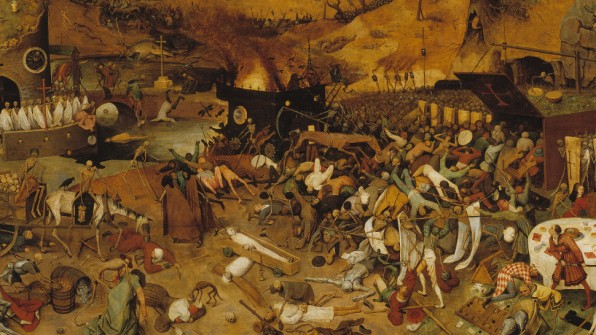
Then the president appears, quotes President Franklin Roosevelt, saying, “The only thing we have to fear is fear itself,” and decries the recent murders of physicians and pharmacists who were rumored to have supplies of the antiviral drugs.
The lead editorial in the next day’s Wall Street Journal disagrees with the president, saying, “The only thing we have to fear is a rampant and deadly influenza epidemic for which this country was totally unprepared and which this administration has been far too slow to respond to.” The editorial traces the 50% decline in American stocks since the beginning of the pandemic, with commensurate drops around the world, and the near collapse of the Chinese exchanges.
Attendance plummets at sporting events, theme parks, and shopping malls. Most public events are now canceled. Major League Baseball is considering temporarily suspending its season. Retailers and park operators have to lay off large percentages of their already diminished workforce. National unemployment soars above 25%, while certain industries can’t find enough qualified workers. Many automobile dealers are now open only on weekends for new car sales, and their service bays are nearly empty. The Federal Reserve lowers the federal funds rate to zero.
Huge poultry farms are culled in Shanghai and Hong Kong, and producers worldwide say there is no reason to build up their stocks again until the pandemic is over, since consumption has tanked. Food supplies are getting tighter and tighter worldwide, even on the grocery store shelves of America.
Although some small towns and rural areas have been largely spared from the infectious scourge, by June a national survey shows that most people say they know someone who has died from the Shanghai flu. Several newspapers have taken to running a photo spread each week of local residents who have perished.
The president appoints a Shanghai flu czar to head a task force made up of the heads of virtually every possible federal government agency with an interest in vaccines, public health, and emergency preparedness. The American manufacturers predict they will be able to produce a steady supply of vaccine beginning in late September, but altogether this will cover no more than 40% of the population for the following five months. No other nation will commit to sending any of their supplies to the United States, given that they are in the same position.
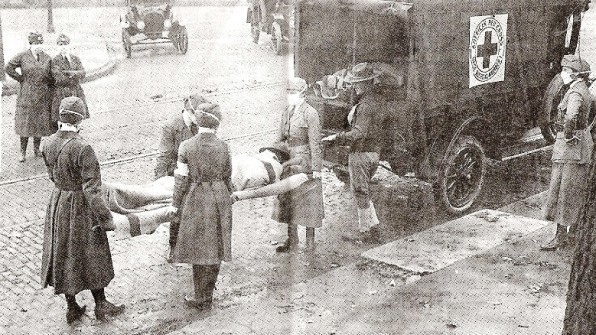
The two countries with large production capacities—India and China—say that they can cover no more than 10% to 15% of their own populations. Early batches of vaccine from one Indian manufacturer turn out to be contaminated with a bacterium and must be thrown out. Everyone begins to realize that most of the world’s population will never have an opportunity to get vaccinated for H7N9. And the question about how well the vaccine works in protecting people from H7N9 infection has not been answered, but it is the only vaccine available.
By the first week of July the casualty rate has started to decline. Within weeks, hospitals are recording only a few new cases. The CDC reports that though there are sporadic hot spots around the world, the flu appears to be abating. The stock market starts to climb, while analysts warn that this may only last until earnings season, when we will see how much damage the pandemic has done. The loss to worldwide gross national product is difficult to measure, but it is certainly in the many trillions of dollars. Everyone says it will take years to recover.
The CDC estimates the total number of cases in the United States at 31 million, or approximately 9% of the population. Of those, deaths totaled approximately 1,932,000, for a fatality rate of around 6%. Global statistics are not yet available but are thought to be at least as severe.
The president proposes August 1 as a day of public reflection and personal commitment, as well as a celebration of the fact that the nation and most of the world has survived its greatest challenge since World War II.
This ordeal has been a message that we all have to pledge ourselves to the common good. We should use both the many examples of great heroism and personal sacrifice and the instances of greed and incredible selfishness during the crisis as a moral compass going forward.
Public health leaders urge the president to postpone such a celebration. They warn that based on the history of previous pandemics, a likely second wave of illness could start in the early fall and actually exceed the number of cases and deaths that occurred in the first. Like the first wave, a second wave could last 10 to 12 weeks in the United States, or even longer. They say it was unfortunate that the world needed so deadly a wake‐up call to take seriously the impact of the influenza pandemic they had been predicting for so long.
Influenza news slowly disappears from television and is relegated to the back pages of newspapers. When the epidemic is mentioned, it is usually in terms of “economic recovery from the Shanghai flu pandemic.”
It is late September when new cases start showing up at physicians’ offices and hospital emergency rooms. The antigen tests quickly confirm H7N9 influenza virus, meaning that the outbreaks earlier that month in Cairo, Egypt, and Lahore, Pakistan, were not flukes.
A series of conference calls is launched by the White House, including the “kitchen sink” of federal, state, and local agencies such as HHS, the CDC, the NIH, the Public Health Service, the FDA, the Department of Defense, the Department of Homeland Security (including the Federal Emergency Management Agency), and state health and emergency preparedness agencies, to organize and coordinate plans to get the new Shanghai flu vaccine distributed throughout the country. It is anticipated that the first vaccine will become available the last week of September in the United States and Canada, and the following week in Great Britain and parts of the EU.
The U.S. vaccine supply will continue to increase by late October, but it is unclear how much will be available, and it will be far less than needed. Anticipating the new stocks, government officials decide that large parking facilities, shopping centers, and stadiums will provide the best venues for vaccination. All sites will be supported by state and local police units.
Despite these precautions, when vaccine does arrive, many locations are overrun by masses of people, and when the supplies are quickly exhausted, the crowds turn violent. Though no one is killed, there are numerous injuries.
The WHO’s director general, who five months before had declared a Public Health Emergency of International Concern, has no advice to offer other than to try to stay away from infected individuals. Surveillance suggests a mortality rate between 4% and 6% in those who contract the Shanghai flu in Western nations, but it is considerably higher in developing nations, where the health care systems have completely broken down. In addition to the influenza deaths, mortality from all other sources has doubled. In Central Africa, vaccine-preventable childhood diseases and TB are said to be out of control because of a lack of basic medical care and public health services.
Hospitals in the United States suffer another round of severe product shortages. They first experience a shortage of saline bags and disposable syringes, but soon supplies of basic lifesaving drugs dwindle. The American Diabetes Association warns for a second time in four months that unless insulin stocks are resupplied soon, people will die. Most hospitals curtail all elective surgeries until further notice. All mechanical ventilators in the United States are in use, but they can treat only a small minority of those who need them. Many others die, particularly the elderly. Again, healthy men and women in the prime of life suffer exaggerated immune system reactions. Pregnant women are especially vulnerable. As with the Zika virus outbreak, health authorities around the world recommend that women of childbearing age postpone pregnancy.
Food shortages happen even faster this time. Because of the run on food stores when the second wave was announced, shelves are largely bare, particularly of meats, dairy products, produce, and other perishables. Many stores close rather than risk looting or vandalism. There is little violence against drugstores this time, though, because it is common knowledge that they have no vaccine or critical pharmaceuticals.
When it is announced that the absentee rate due to the influenza is approaching 30%, there is fierce debate in Congress and in the media on whether to allow Mexican seasonal workers into the country to harvest crops. Conservative lawmakers worry that they will bring even more disease with them. The NIH director is called before the U.S. Senate Committee on Health, Education, Labor and Pensions. The committee chairman reads statements in which the director has repeatedly predicted over the past five years that a universal influenza vaccine will be forthcoming, yet none exists. The director mumbles something about funding and commitment but has no real response.
In New York, the subway system has virtually shut down as commuters realize they cannot avoid being breathed on. The streets are essentially gridlocked with private cars. The director of the Environmental Protection Agency warns of dangerous levels of air pollution. It is difficult to estimate the daily loss of productivity, but it is clearly in the tens of millions of dollars.
The world’s stock exchanges, which had been gradually creeping up since July, plunge again, giving up another large percentage of their already anemic value. The gross national products of all developed nations have decreased by nearly half and the world is officially in economic depression. The American unemployment rate reaches 22%—less than three points below that of 1933: the worst year of the Great Depression.
By now, almost every major city around the world is witnessing people dying in offices, in public buildings, and right on the streets. Morgues are overflowing with bodies and there is a worldwide shortage of coffins. Developing countries begin cremating corpses in large ditches that are then immediately covered over by bulldozers. In the United States and other First World nations, morgues are forced to supplement with freezer trucks, but the spot shortages of electricity and fuel are forcing some difficult decisions on disposal.
Certain right-wing televangelists state that Shanghai flu is God’s punishment for straying from his ways. Public health leaders condemn this “dangerous and irresponsible fearmongering that can only distract us from our real challenges.” They emphasize that “no one is responsible for becoming ill, but all should take whatever precautions they can.”
The American president and the other leaders of the G7 nations meet via secure video link because of the concern about travel. They release a statement that the H7N9 pandemic “is the moral equivalent of war,” with all the world’s people engaged together in a mortal battle with a common enemy deadlier than any human adversary.
In most places, panic and civil strife have now given way to an overriding sense of resignation. Streets of major cities are close to empty. Stores, restaurants, and entertainment venues are closed. Researchers are more certain how the H7N9 changed into the pandemic strain, but to most of the public, the question seems largely academic. Vaccine stocks continue to trickle in and are quickly used, but so many people have suffered or died from the illness that demand is actually beginning to drop.
By the following June, when the pandemic has finally run its primary course, the worldwide death toll from the two disease waves is approximately 360 million, out of nearly 2.22 billion total cases. The average age of those who died is 37. While the percentage of those who have died around the world does not come close to that of those who died in the Black Death, which wiped out nearly a third of the population of Europe and the Mediterranean region in the 14th century, in terms of raw morbidity and mortality statistics, the Shanghai influenza pandemic is by far the largest catastrophe in world history.

The preceding scenario is fictional but far from fanciful.
On May 10, 2016, the National Health and Family Planning Commission of China notified the WHO of 11 new cases of laboratory-confirmed human infection with H7N9 influenza.
Four of the patients had died and two more were in critical condition at the time of the report. The two in critical condition—a 23-year-old male and a 43-year-old female—had exposure to each other. Therefore, the WHO noted, “Human-to-human transmission between the two patients cannot be ruled out.” Such infections with this virus, it warned, “are unusual and need to be monitored closely in order to identify changes in the virus and/or its transmission to humans as it may have a serious public health impact.”
In the WHO’s latest report, covering the period between February 24 and March 7, 2017, China and Hong Kong declared a total of 58 additional confirmed cases of human infection, with three clusters of “possible human to human transmission.” Although “current epidemiological and virological evidence suggests that this virus has not acquired the ability of sustained transmission among humans,” the report said the WHO “encourages countries to continue strengthening influenza surveillance, including surveillance for severe acute respiratory infections (SARI) and influenza-like illness (ILI) and to carefully review any unusual patterns, ensure reporting of human infections . . . and continue national health preparedness actions.”
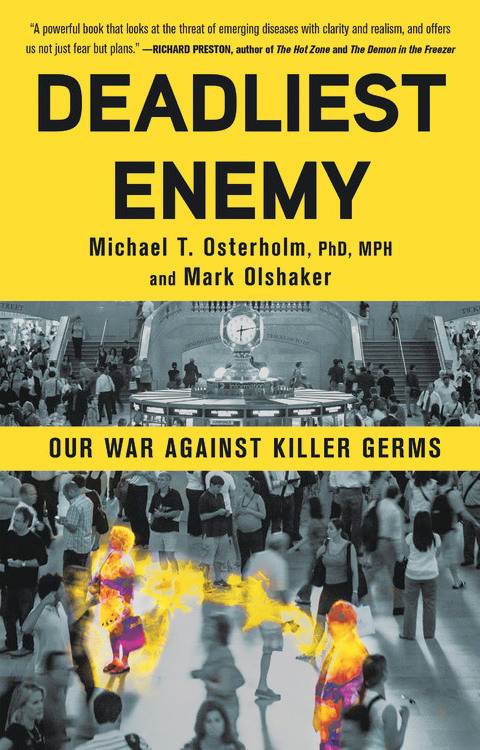
Few people see this more clearly than Ron Klain, who oversaw our international response to the Ebola outbreak in West Africa:
. . . It seems likely that the world is living on borrowed time before one of these new infectious disease threats becomes the kind of global pandemic we have all been warned to expect. It is not hard to imagine that some time during this president’s term, his or her national security team may be summoned to the Oval Office to discuss a catastrophic pandemic of historic proportions: more than 1 million deaths in just a few weeks in a far corner of the world, sparking the fall of several governments, giving rise to a violent regional conflict over scarce resources, and unleashing a refugee crisis as fleeing victims encounter panic and closed borders at every turn. Worse still, the president will be told, there is an increasing risk that such death and disruption may soon arrive in the United States.
There is no way to know how many warnings we will get before the events we have portrayed here become all too possible. They may not be far off.
Mike Osterholm is regents professor, McKnight presidential endowed chair in public health, and the founding director of the Center for Infectious Disease Research and Policy (CIDRAP) at the University of Minnesota. Mark Olshaker is an Emmy Award-winning documentary filmmaker and author.
Excerpted from Deadliest Enemy, copyright © 2017 by Dr. Mike Osterholm and Mark Olshaker. Used with permission of Little, Brown and Company, New York. All rights reserved.
Fast Company , Read Full Story
(32)

